
Who makes good quality USB cables?
Complete USB Cable Manufacturing Process Guide
In our daily lives, USB cables have become indispensable companions, facilitating seamless connections between our devices, enabling rapid phone charging, and ensuring swift file transfers. Despite their ubiquitous presence, have you ever paused to ponder the meticulous process behind their creation? The seemingly ordinary-looking USB cables are the result of a sophisticated manufacturing journey that combines cutting-edge technology, precision engineering, and stringent quality control measures.
we take pride in being more than just a mass producer of USB data cables. We are your trusted partner in business, committed to delivering products that exceed expectations in terms of quality, functionality, and reliability. In this blog, we invite you to embark on a behind-the-scenes tour of our USB cable manufacturing process, from the selection of raw materials to the final quality inspection and delivery.
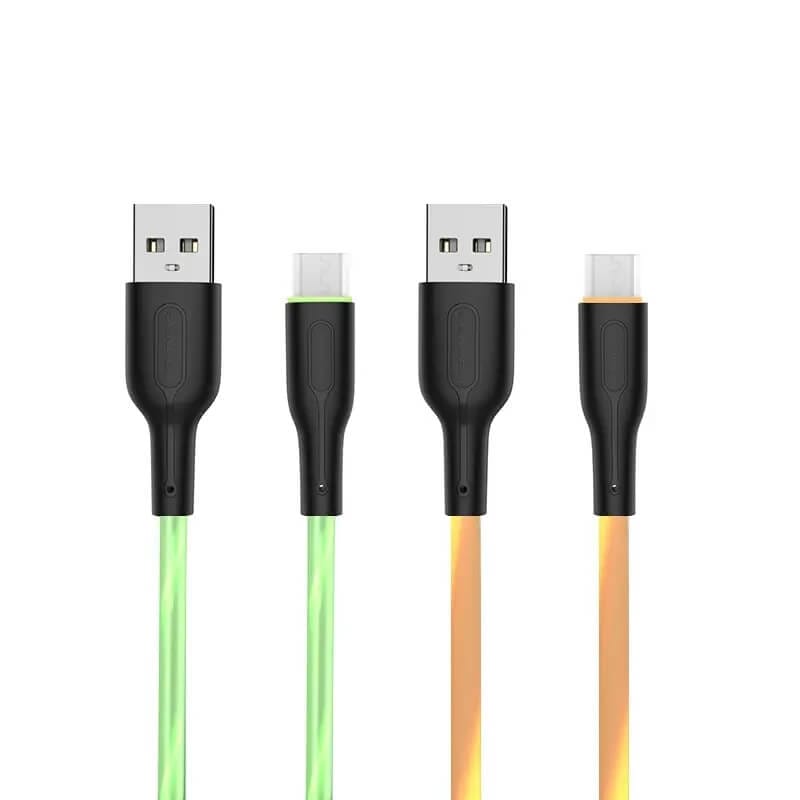
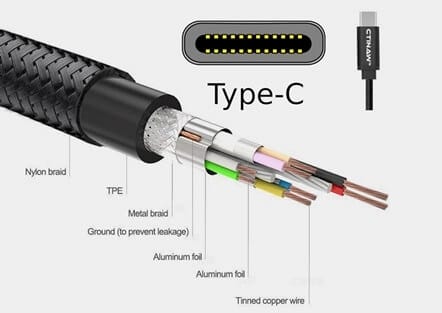
The Construction of a USB Cable
The manufacturing process of USB cables is a multi-step procedure that demands unwavering precision and meticulous attention to detail. Each stage plays a crucial role in ensuring the production of high-quality cables that meet the rigorous standards of modern technology. Let’s delve into the intricacies of each step:
Step 1: Connector Production
The manufacturing process commences with the production of connectors, which serve as the interface between the cable and the device. we utilize semi-automated machines to assemble connectors with utmost precision. The process begins with the injection of shells into the machine, followed by two distinct operations depending on the cable type:
- MFI (Made for iPhone/iPad/iPod) Cables: For MFI-certified cables, the MFI chip is meticulously packaged onto the circuit board at this stage. This chip ensures seamless compatibility with Apple devices and enables secure communication between the cable and the device.
- Fast-Charging Cables: In the case of fast-charging cables supporting 100W or more, the E-Marker chip for intelligent power control is integrated into the circuit board. This chip plays a vital role in regulating the power flow, ensuring safe and efficient charging of devices.
Once the circuit boards are inserted into the shells, plastic backing pieces are attached to complete the connectors. These connectors are then ready for the next stage of the manufacturing process.
Step 2: Cable Production
The next phase involves the production of the cable itself, a process that encompasses several sub-steps:
- Wire Drawing: The journey begins with the creation of metal wires, typically made of copper or aluminum. These wires are produced by pulling a copper or aluminum rod through a series of specialized diamond dies on a drawbench. This process, known as wire drawing, subjects the metal rod to intense pressure, gradually reducing its diameter and increasing its length.
- Annealing: After the wire is drawn, it undergoes an annealing process to enhance its flexibility and ductility. Annealing involves heating the wire to a specific temperature and then cooling it slowly, which helps to relieve internal stresses and improve the wire’s electrical conductivity.
- Twisting and Stranding: The flexible wires are then twisted and stranded together using a precise method to ensure optimal flexibility and electrical performance. This process involves combining multiple wires into a single strand, which helps to reduce electromagnetic interference and improve the cable’s overall durability.
- Insulation Extrusion: Once the wires are twisted and stranded, they are passed through an extruder, which coats them with a layer of insulating material, usually plastic. This insulation serves to protect the wires from damage, prevent electrical short circuits, and ensure safe operation of the cable.
- Cooling and Winding: After the insulation is applied, the cable is cooled down and wound onto reels for further processing. This step helps to ensure that the cable is properly formed and ready for the next stage of the manufacturing process.
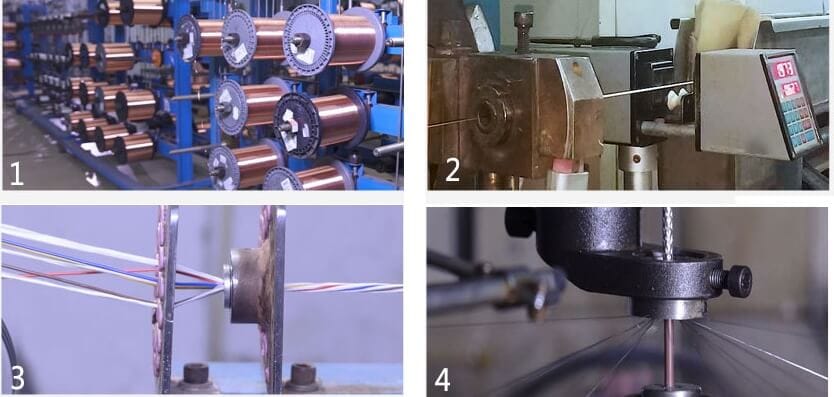
Step 3: Cable Assembly
The cable assembly stage involves combining the wires and connectors to create the final USB cable. This process is tailored to meet the specific requirements of the USB transfer standard and fast charging power capabilities:
- Winding: The first step in cable assembly is winding the wire cores according to the desired USB transfer standard and charging power. The number of wire cores and their specifications are determined by the USB wiring schematic diagram and the connector type.
- During this process, the wire cores are wrapped with shielding net and aluminum foil to protect them from electromagnetic interference and ensure reliable data transmission.
- Outer Protective Layer: Once the wire cores are wound and shielded, the cable is covered with an outer protective layer, typically made of PVC, TPE, or nylon braid. The choice of material depends on the intended use of the cable and the customer’s specific requirements. This outer layer provides additional protection against physical damage, abrasion, and environmental factors.
Step 4: Cutting Cable Length
After the cable is assembled, it is cut to the desired length, such as 1 meter or 2 meters, to meet the specific needs of customers. This step ensures that the cable is the perfect size for various applications and provides a convenient and user-friendly experience.
Step 5: Thermal Stripping of the Jacket Material At Both Ends Of The Cable
Once the cables are cut to the appropriate length, the next crucial step is wire stripping. This involves removing the outer insulation of the cable to expose the inner wires, which are then prepared for soldering.
Specialized wire stripping machines are used to ensure precise and consistent stripping, minimizing the risk of damage to the inner wires. After the jacket is stripped, the foil is trimmed, and the inner wires are twisted together to ensure proper electrical connection.
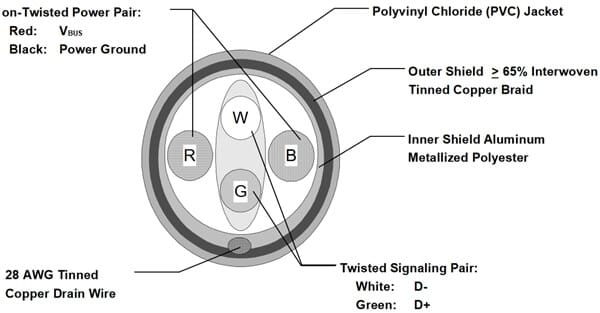
Step 6: Solder the Connector to the Cable
In this step, the connectors are soldered to the internal wire assembly.
Different connector types, such as USB-A, Micro USB, Lightning, and USB-C, have specific pin arrangements that require careful alignment of the wire cores.
Specialized welding machines are used to apply controlled heat and melt high-quality solder, ensuring a secure and reliable connection between the wire cores and the connectors. After soldering, each connection point is carefully inspected using high-powered magnifiers to ensure full-strength bonds and flawless joins. Only cable assemblies that pass this rigorous quality audit proceed to the next stage of production.
Step 7: First Port Shape Injection Molding
To safeguard the soldered connections and enhance the cable’s stability, strength, and durability, an injection molding machine is used to apply the primary mold to the connector.
This primary molding, also known as internal molding, provides an initial layer of protection by encapsulating the soldered area with a tough material, usually plastic SGP. This process helps to prevent the connectors from bending, breaking, or becoming damaged during normal use.
Step 8: First Electrical Test
After the primary molding is complete, the USB cables are subjected to a comprehensive electrical performance test to ensure 100% electrical conduction capability. Specialized electrical test devices are used to measure the electrical resistance, capacitance, and other parameters of the cables, ensuring that they meet the required specifications and standards. Any cables that fail this test are immediately rejected and sent back for further inspection and repair.
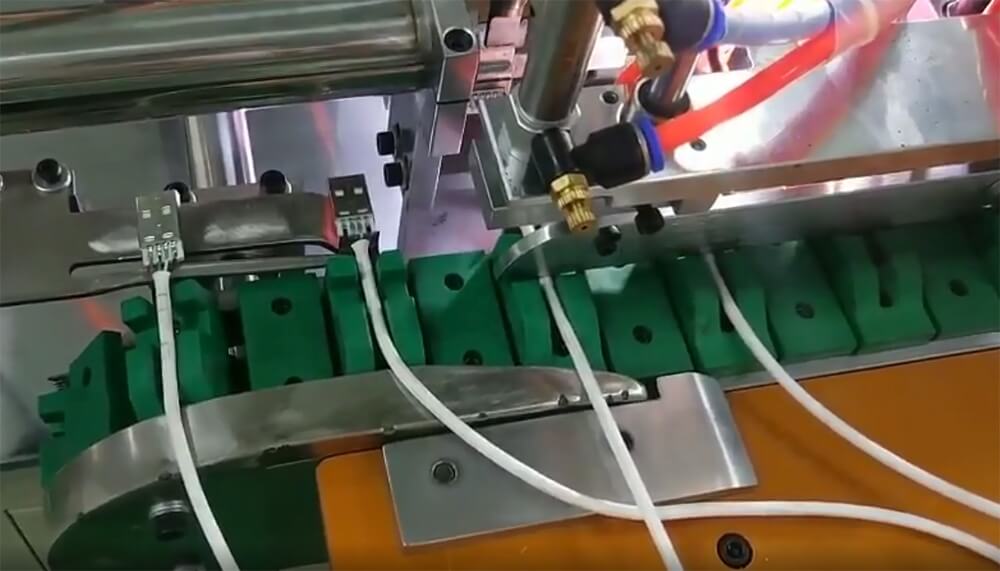
Step 9: Second External Injection Molding/Installation of Port Housing
Following the electrical performance test, the semi-finished products are transferred to an external injection molding machine for the final layer of protection. This process typically involves molding the port housing onto the cables using PVC soft material. The port housing provides an additional layer of protection against physical damage, abrasion, and environmental factors, ensuring the longevity and reliability of the cables. In some cases, customized cable port shells may be used instead of injection molding, depending on the customer’s specific design requirements. These shells can be made of various materials, such as hard plastic or aluminum alloy, and offer a more personalized and aesthetically pleasing appearance.
Step 10: Second Electrical Performance Test
After the external injection molding is complete, the cables undergo a second electrical performance test to ensure that they maintain their electrical conductivity and functionality despite the additional layers of protection.
This test is crucial to ensure that the cables meet the required specifications and standards and are suitable for use in various applications. Any cables that fail this test are rejected and sent back for further inspection and repair.

Step 11: Visual Inspection and Quality Testing
Once the manufacturing process is complete, each cable undergoes a rigorous visual inspection to ensure that it meets the highest quality standards.
During this inspection, technicians carefully examine each cable for any signs of defects, such as holes, bulges, or improper port formation. In addition to the visual inspection, random spot testing is performed to assess the cable’s performance and durability under various conditions. These tests include:
- Push and Pull Force Test: This test measures the force required to push or pull the cable, ensuring that it can withstand normal usage without breaking or becoming damaged.
- Salt Spray Test: The salt spray test evaluates the cable’s resistance to corrosion and rust by exposing it to a saline mist. This test simulates harsh environmental conditions, such as exposure to saltwater or humidity, and helps to ensure the cable’s longevity and reliability.
- Swing Tensile Test: This test assesses the cable’s tensile strength and flexibility by subjecting it to repeated bending and stretching. This test helps to ensure that the cable can withstand frequent movements without weakening or breaking.
- Pull and Plug Test: The pull and plug test evaluates the durability of the cable’s connectors by repeatedly inserting and removing them. This test helps to ensure that the connectors maintain a secure connection over time, even with frequent use.
- Constant Temperature Test: The constant temperature test evaluates the cable’s performance under extreme temperature conditions by exposing it to high and low temperatures. This test helps to ensure that the cable can operate reliably in different environments and conditions.
By conducting these rigorous quality tests, we are able to identify and eliminate any potential defects or issues, ensuring that only high-quality cables are delivered to our customers. This meticulous quality control process helps us to uphold our reputation for excellence and ensures customer satisfaction with our products.
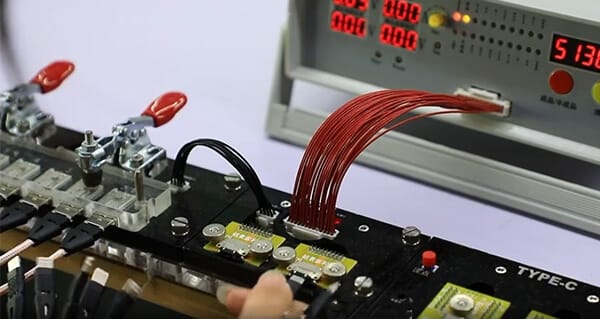
Step 12: Cooperate with OED&ODM to Customize Brand Packaging
we understand the importance of brand identity and the role that packaging plays in promoting products. That’s why we offer a range of customized branding and packaging solutions to meet the specific needs of our customers. Our OEM&ODM services include laser engraving, screen printing, and the design of both internal and external packaging materials and styles.
We work closely with our customers to understand their brand identity and marketing goals, and we use this information to create packaging solutions that are both visually appealing and functional.
Step 13: Packaging Process
The final step in the manufacturing process is the packaging of the cables.
Our packaging process is designed to ensure that the cables are protected during transportation and storage and that they arrive at their destination in perfect condition. The packaging process includes the following steps:
- Twisted Wire Method: The cables are carefully arranged using the twisted wire method to prevent tangling and ensure that they remain neat and organized during transportation and storage.
- Bundling: The cables are bundled together securely to prevent any damage or fraying during transit. This helps to ensure that the cables stay protected and maintain their quality until they reach the end user.
- Inner Packaging: Once bundled, the cables are placed in inner packaging materials, such as boxes or bags, to provide additional protection and cushioning. This helps to safeguard the cables from bumps and impacts during shipping.
- Outer Packaging: Finally, the inner packaging containing the cables is placed into outer packaging materials, such as corrugated cardboard boxes or envelopes, to provide an additional layer of protection and serve as the primary barrier against external elements. This helps to ensure the safe delivery of the cables to our customers.
Step 14: Delivery Process
we understand the importance of timely and reliable delivery. That’s why we work closely with trusted logistics partners to ensure that our products are delivered to our customers’ specified locations in a timely and efficient manner. Our logistics team handles all aspects of the delivery process, from scheduling pickup to tracking the shipment’s progress until it reaches its destination. We also offer the option to deliver the cables directly to our customers’ chosen freight forwarder, providing them with greater control over the shipping process and allowing them to seamlessly integrate the delivery into their existing supply chain operations.
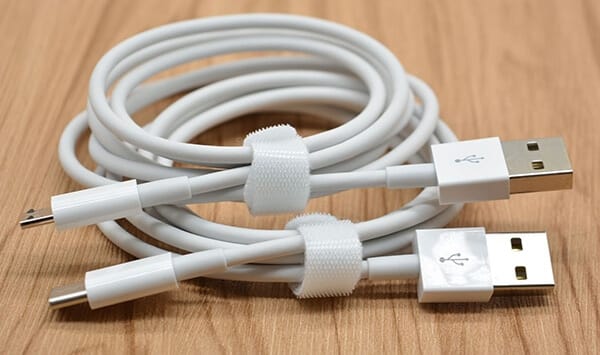
Collaborate : Your Ultimate USB Cable Partner
The above is the standard process for mass production of USB cables. For special customized products, we offer free proofing services before mass production to ensure that the product functions meet our customers’ expectations.
We understand that every customer has unique requirements, and we are committed to providing tailored solutions to meet their needs. Our team of experienced engineers and designers works closely with our customers to understand their specific requirements and develop customized solutions that are both innovative and reliable.
we are dedicated to providing superior products and services that exceed our customers’ expectations. Our comprehensive manufacturing process, commitment to quality control, and focus on innovation make us the preferred choice for all your USB cable needs. Whether you are looking for standard USB cables, fast-charging cables, or customized solutions, we have the expertise and experience to deliver products that meet your specific requirements. Contact us today to learn more about our products and services and to discuss your specific needs.

